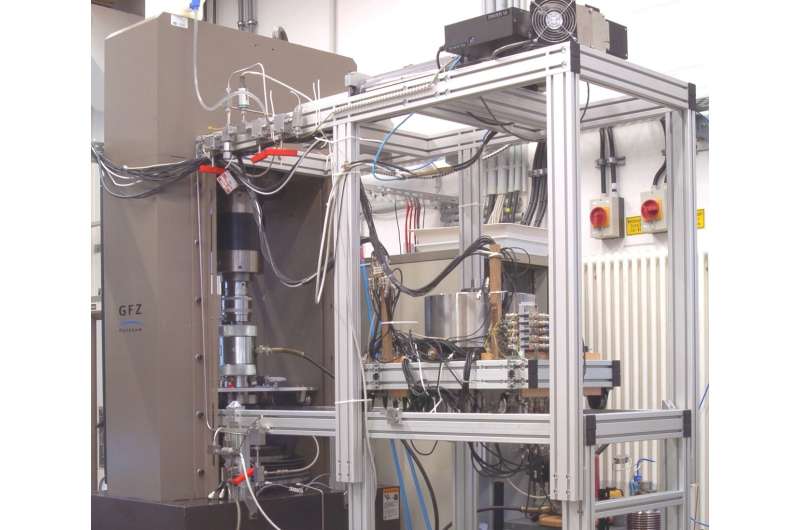This article has been reviewed according to Science X's editorial process and policies. Editors have highlighted the following attributes while ensuring the content's credibility:
fact-checked
peer-reviewed publication
trusted source
proofread
Understanding man-made earthquakes: Study highlights role of fault roughness and stress heterogeneity

Man-made earthquakes, or induced seismicity, have become an increasing concern. These events can occur during fluid injection or extraction, such as in oil or gas reservoirs, wastewater disposal, or geothermal reservoirs.
In a few cases, larger "runaway induced earthquakes" were strong enough to cause public concern and stop projects (e.g. 2006 Basel/Switzerland) or even substantial damage (2017 Pohang/South Korea). Intense research, however, has resulted in successful attempts to avoid such runaway events such as in the Helsinki geothermal project in 2018. The key to systematically avoiding large induced earthquakes is to better understand the underlying physical processes.
In a new study published in the Proceedings of the National Academy of Sciences, Dr. Lei Wang and his colleagues from the GFZ Section "Geomechanics and Scientific Drilling," together with researchers from the University of Oslo, Norway, report that the roughness of pre-existing faults and associated stress heterogeneity in geological reservoirs play a key role for causing such runaway events.
The study combines novel fluid injection experiments under acoustic monitoring performed in GFZ's geomechanical laboratory with numerical modeling results.
"We found that rough and smooth faults in the rocks behaved entirely differently during our laboratory experiments. This is an exciting observation as we evidenced the progressive localization of microseismic activity indicating stress transfer before large induced events during fluid injection," says the first author Dr. Wang who designed and performed the experiments and the modeling.
Injection-induced seismicity in the lab highlights the important role of fault roughness
Roughness for active faults and fractures along tectonic faults, as well as pre-existing but inactive faults in geological reservoirs, are difficult to characterize. To overcome the insufficient resolution when imaging or monitoring such faults in nature, the research group 'down-sized' to the decimeter-scale preparing laboratory faults with defined surface roughness. Those were then pressurized to near-critical stress states using a triaxial MTS compression apparatus.
The rock samples were also equipped with multiple sensors, including piezo-based lab seismometers, to monitor thousands of tiny earthquakes, so-called Acoustic Emissions, indicating deformation inside the pressurized rocks before they break. Fluid injection was then performed into the samples, simulating fluid injection in geological reservoirs.
"Controlling the boundary conditions and using a dense monitoring network in the lab enabled us to image the evolution of induced laboratory earthquakes as well as slow aseismic deformation and derive key parameters such as fault slip and slip rate, providing a comprehensive image to better understand the physics of injection-induced seismicity," says Georg Dresen, professor in GFZ's Section Geomechanics and Scientific Drilling, who supervised and initiated the study.
Compared to smooth faults, injection-induced slip on rough faults produces spatially localized clusters of Acoustic Emissions occurring around highly stressed asperities. It is there that induced local slip rates are higher, accompanied by a relatively higher number of large events.
This mechanism is typically measured in the "Gutenberg–Richter b-value" as a measure of stress. Fluid injection first reactivates the fault patches through slow, aseismic slip and causes only a few small seismic events, followed by a progressive localization, ultimately leading to large induced events.
"This study has important implications for induced earthquakes: It means that when monitoring fluid injections in geological reservoirs in real-time, this may allow identifying such localization processes before the nucleation of larger induced events allowing to avoid them," says Prof. Marco Bohnhoff, head of GFZ's section Geomechanics and Scientific Drilling.
The similarities between laboratory-scale and field-scale induced seismicity
To further investigate the relevance of the lab experiments for earthquakes in geological reservoirs, the authors compiled a wide range of datasets of induced seismicity studying the emitted energy as a function of hydraulic energy from laboratory-scale and in-situ fluid injection experiments, as well as from reservoir-scale hydraulic fracturing, from geothermal and waste-water disposal projects around the world.
The value of seismic injection efficiency (i.e., the ratio of energy emitted in earthquakes to the hydraulic energy that is put in the system by fluid injection) separates pressure-controlled ruptures from runaway ruptures. In contrast to runaway events with high seismic injection efficiencies, induced seismicity showing an extended pressure-controlled rupture typically shows a much lower seismic injection efficiency.
Dr. Wang emphasizes that "our laboratory observations bear similarities with those field-scale induced earthquakes corresponding to pressure-controlled ruptures, as reflected by the fact that in our experiments, the induced fault slip terminates shortly after we stop fluid injection."
The goal is to ultimately control and avoid large induced earthquakes
The study is part of a recently started research initiative aiming to better forecast induced earthquakes in geological reservoirs and ultimately also large catastrophic natural earthquakes. Part of this initiative is to bring the processes from the field scale into the laboratory where boundary parameters can be controlled, and the processes leading to seismic events can be reproduced.
Marco Bohnhoff concludes, "Only novel data processing approaches and tuning classical seismological methods to analyze earthquakes, now also in the lab, form the basis for understanding the rock deformation processes in greater detail."
"Studies such as the one now published by Wang and his co-authors host the potential to mitigate man-made seismic hazards, which is a pre-condition to reach public acceptance when using the geological underground for energy storage and extraction as a key element of the energy transition."
More information: Lei Wang et al, Fault roughness controls injection-induced seismicity, Proceedings of the National Academy of Sciences (2024). DOI: 10.1073/pnas.2310039121
Journal information: Proceedings of the National Academy of Sciences
Provided by Helmholtz Association of German Research Centres



















